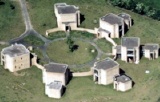EPSRC Symposium Capstone Conference
Mini Symposium on Mathematical Neuroscience
Organiser: Stephen Coombes (Mathematical Sciences, Nottingham)
Tuesday 30 June 2009
Speakers:
Peter Ashwin (Engineering, Computer Science and Mathematics, Exeter) P.Ashwin@exeter.ac.uk http://www.secamlocal.ex.ac.uk/people/staff/pashwin/
Winnerless competition for coupled neural dynamics
Idealized models of neural dynamics (such as neural networks) tend to make much use of variational dynamics, by assuming the presence of an "energy functional". These models suggest that neural computations occur by following a path that successively minimizes this functional, but there is no particular reason to believe that such a functional exists except possibly locally in phase space. Work in the past few years by Huerta, Rabinovich and others has suggested that certain neural processes work instead by means of "winnerless competition". In such models this translates into dynamics that explores many dimensions but in a very structured way: a heteroclinic attractor. This talk with discuss some recent work on neurally plausible models that give rise to such dynamics, and how this could be of relevance to cognitive puzzles such as binocular rivalry and neural resting states.
Antoni Guillamon (Applied Mathematics, Barcelona) antoni.guillamon@upc.edu http://www.ma1.upc.edu/%7Etonig/index_ang.htm
Phase resetting surfaces: extending phase resetting curves out of the periodic attractors
The knowledge of the phase advancement after a given stimulus is an important point for the control of biological oscillators. We will present a numerical method to perform the effective computation of the phase advancement when we stimulate an oscillator which has not reached yet the asymptotic state (a limit cycle). That is, we extend the computation of the phase resetting curves (the classical tool to compute the phase advancement) to a neighborhood of the limit cycle, obtaining what we call the phase resetting surfaces (PRS). To achieve this goal we first perform a careful study of the theoretical grounds (the parameterization method for invariant manifolds and another approach using Lie symmetries), which allows to describe the isochronous sections of the limit cycle and, from them, to obtain the PRSs. We will explain how we make this theoretical framework applicable, by using the numerical algorithms of the parameterization method and other semianalytical tools to extend invariant manifolds; as a result, we design a numerical scheme to compute both the isochrons and the PRSs of a given oscillator. Finally, to illustrate this algorithm, we will show its application to some well-known biological models. We will put strong emphasis in the biological implications and provide new examples that reinforce the usefulness of the phase resetting surfaces.
Carlo Laing (Information and Mathematical Sciences, Massey University) c.r.laing@massey.ac.nz http://www.massey.ac.nz/~crlaing/
Dimension reduction in neural models: an example – binocular rivalry
Yulia Timofeeva (Computer Science, Warwick) y.timofeeva@warwick.ac.uk http://www.dcs.warwick.ac.uk/~yulia/
Mathematics of dendritic democracy
See also:
Mathematics Research Centre
Mathematical Interdisciplinary Research at Warwick (MIR@W)
Past Events
Past Symposia
Where possible, visitors should obtain an EDUROAM account from their own university to enable internet access whilst at Warwick.
You can register for any of the symposia or workshops online. To see which registrations are currently open and to submit a registration, please click hereLink opens in a new window.
Mathematics Research Centre
Zeeman Building
University of Warwick
Coventry CV4 7AL - UK
E-mail:
MRC@warwick.ac.uk

